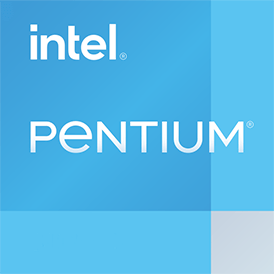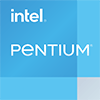
Intel Pentium

Generazione Attuale: 12.
Architettura attuale: Alder Lake U
Tecnologia : 10 nm
Design a chip: Monolitico
Set di istruzioni: SSE4.1, SSE4.2, AVX2
Virtualizzazione: VT-x, VT-x EPT, VT-d
L'ultima generazione di processori Intel Pentium, come l'Intel Pentium 8500, si basa sull'architettura Intel Core i, ma ha meno core della CPU. Anche le frequenze di clock delle CPU Intel Pentium sono generalmente inferiori a quelle dei più piccoli processori Intel Core i3. L'hyperthreading per il raddoppio dei thread della CPU e una modalità turbo non sono disponibili, ma sia la RAM AES-Ni che la RAM ECC sono state supportate dalla sesta generazione. Tuttavia, quest'ultimo supporto è stato nuovamente ritirato perché i processori Intel Pentium erano troppo economici per il produttore nel segmento dei mini-server. I processori Pentium ora hanno anche tutte le funzioni di virtualizzazione, incluso VT-d.Architettura attuale: Alder Lake U
Tecnologia : 10 nm
Design a chip: Monolitico
Set di istruzioni: SSE4.1, SSE4.2, AVX2
Virtualizzazione: VT-x, VT-x EPT, VT-d
Contrariamente alla descrizione, la grafica Intel HD integrata è veloce quasi quanto quella della serie Intel Core i (desktop). Ma non è abbastanza per i giochi attuali. In generale, gli Intel Pentium non sono male nei giochi e, abbinati a una scheda grafica dedicata (esterna), di solito possono visualizzare i giochi attuali senza problemi fintanto che la risoluzione è ridotta. Inoltre, la scheda grafica dedicata dovrebbe essere un modello entry-level, poiché le schede grafiche di fascia alta non sono completamente utilizzate da un processore Intel Pentium. I processori Intel Core i5 o Core i7/i9 sono più adatti qui.
I processori Intel Pentium sono destinati principalmente al PC da ufficio medio, anche Adobe Photoshop funziona piacevolmente velocemente sui processori Pentium. I processori Intel Pentium sono attualmente utilizzati solo nel settore desktop, in particolare i modelli a risparmio energetico sono contrassegnati da una T nella designazione dell'articolo e hanno una frequenza di clock ridotta (e quindi sono più lenti).
I processori Intel Pentium non sono sempre basati sulla generazione Intel Core, ma si basano anche sulla piattaforma Intel Atom. Si consiglia quindi di verificare le prestazioni del processore prima di effettuare un acquisto, in quanto queste possono variare notevolmente. Inoltre, in alcune aree può avere senso tenere d'occhio i processori Intel Celeron più piccoli, alcuni dei quali sono quasi alla pari con i loro fratelli Pentium più grandi.
Tutti Intel Pentium CPUs
| Processore | Generazione | ||
 |
Intel Pentium Gold 8505 5C 6T @ 1,20 GHz |
12. | |
 |
Intel Pentium Gold 8500 5C 6T @ 1,00 GHz |
12. | |
 |
Intel Pentium N6415 4C 4T @ 1,20 GHz |
11. | |
 |
Intel Pentium N6211 4C 4T @ 1,20 GHz |
11. | |
 |
Intel Pentium J6426 4C 4T @ 2,00 GHz |
11. | |
 |
Intel Pentium Gold G7400TE 2C 4T @ 3,00 GHz |
11. | |
 |
Intel Pentium Gold G7400T 2C 4T @ 3,10 GHz |
11. | |
 |
Intel Pentium Gold G7400E 2C 4T @ 3,60 GHz |
11. | |
 |
Intel Pentium Gold G7400 2C 4T @ 3,70 GHz |
11. | |
 |
Intel Pentium Gold 7505 2C 4T @ 2,00 GHz |
11. | |
 |
Intel Pentium Silver N6005 4C 4T @ 2,00 GHz |
10. | |
 |
Intel Pentium Silver N6000 4C 4T @ 1,10 GHz |
10. | |
 |
Intel Pentium Gold G6605 2C 4T @ 4,30 GHz |
10. | |
 |
Intel Pentium Gold G6600 2C 4T @ 4,20 GHz |
10. | |
 |
Intel Pentium Gold G6505T 2C 4T @ 3,60 GHz |
10. | |
 |
Intel Pentium Gold G6505 2C 4T @ 4,20 GHz |
10. | |
 |
Intel Pentium Gold G6500T 2C 4T @ 3,50 GHz |
10. | |
 |
Intel Pentium Gold G6500 2C 4T @ 4,10 GHz |
10. | |
 |
Intel Pentium Gold G6405T 2C 4T @ 3,50 GHz |
10. | |
 |
Intel Pentium Gold G6405 2C 4T @ 4,10 GHz |
10. |
Intel Pentium lista delle generazioni
| Cognome | Generazione | Segmento | Tecnologia | Architettura |
| Intel Pentium Gold 8000 | 12. | Mobile | 10 nm | Alder Lake U |
| Intel Pentium 7000 | 11. | Mobile | 10 nm | Tiger Lake U |
| Intel Pentium G7000 | 11. | Desktop / Server | 10 nm | Alder Lake S |
| Intel Pentium N6200/J6400/N6400 | 11. | Mobile | 10 nm | Elkhart Lake |
| Intel Pentium N6000 | 10. | Mobile | 10 nm | Jasper Lake |
| Intel Pentium 6000 | 10. | Mobile | 14 nm | Comet Lake U |
| Intel Pentium 6000Y | 10. | Mobile | 14 nm | Amber Lake U |
| Intel Pentium G6000 | 10. | Desktop / Server | 14 nm | Comet Lake S |
| Intel Pentium J5000/N5000 | 9. | Mobile | 14 nm | Gemini Lake |
| Intel Pentium 5000 | 8. | Mobile | 14 nm | Whiskey Lake U |
| Intel Pentium G5000 | 8. | Desktop / Server | 14 nm | Coffee Lake S |
| Intel Pentium J4000/N4000 | 8. | Mobile | 14 nm | Apollo Lake |
| Intel Pentium 4400 | 7. | Mobile | 14 nm | Kaby Lake U |
| Intel Pentium G4000 | 7. | Desktop / Server | 14 nm | Kaby Lake S |
| Intel Pentium J3000/N3700 | 7. | Desktop / Server | 14 nm | Braswell |
| Intel Pentium 4000 | 6. | Mobile | 14 nm | Skylake U |
| Intel Pentium G4000 | 6. | Desktop / Server | 14 nm | Skylake S |
| Intel Pentium J2000/N3500 | 6. | Desktop / Server | 22 nm | Bay Trail |
| Intel Pentium D | 5. | Desktop / Server | 14 nm | Broadwell |
| Intel Pentium G3000 | 5. | Desktop / Server | 14 nm | Haswell S |
| Intel Pentium 2000 | 4. | Mobile | 22 nm | Ivy Bridge U |
| Intel Pentium 3000 | 4. | Mobile | 22 nm | Haswell U |
| Intel Pentium G2000 | 4. | Desktop / Server | 22 nm | Ivy Bridge S |
| Intel Pentium 900 | 3. | Mobile | 32 nm | Sandy Bridge U |
| Intel Pentium G800 | 3. | Desktop / Server | 32 nm | Sandy Bridge S |
| Intel Pentium E5000/E6000 | 2. | Desktop / Server | 45 nm | Wolfdale (Penryn) |
| Intel Pentium T4000/SU4000 | 2. | Mobile | 45 nm | Penryn |
| Intel Pentium T2000/T3000 | 1. | Mobile | 65 nm | Merom (Core) |
| Intel Pentium M | 1. | Mobile | 90 nm | Dothan |
| Intel Pentium D | Desktop / Server | 65 nm | Presler |
Torna all'indice



